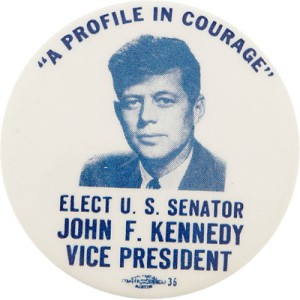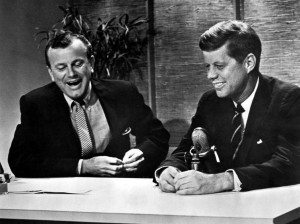by John T. Shaw
John F. Kennedy
The political career of John F. Kennedy skyrocketed in 1956. Through a mixture of careful planning, hard work, tough-minded organization, and remarkably good fortune, Kennedy catapulted from promising politician to potential star. There was a clear cascading effect: each opportunity and success engendered future opportunities and successes. He was on a seemingly continuous upward cycle. By the summer of 1956, with the November presidential election approaching, Kennedy’s name began to appear on lists as a possible vice presidential nominee on a ticket that Adlai Stevenson, the former Illinois governor and the 1952 Democratic nominee, was expected to head. Stevenson had run a spirited and competitive race against Dwight Eisenhower in 1952 and was widely seen as the Democratic Party’s best hope against the incumbent president. A Newsweek article that summer mentioned Kennedy as one of the leading contenders for the vice presidential nomination, along with Senator Hubert Humphrey of Minnesota, Senator Estes Kefauver of Tennessee, and Governor Robert Meyner of New Jersey.

As Kennedy was discussed as a possible vice presidential nominee, his staff quietly, but forcefully, advanced his candidacy for the number two spot. Ted Sorensen researched and wrote a memo that argued that Kennedy’s Catholicism could be an asset rather than a liability for the Democratic ticket that fall. The Sorensen memo was given to John Bailey, chairman of the Democratic Party in Connecticut, who circulated it under his own name. The Bailey memorandum, titled “The Catholic Vote in 1952 and 1956,” argued that there were 14 electorally critical states with large adult Catholic populations, ranging from 20 percent in Ohio to 60 percent in Rhode Island. Democrats needed to win those 14 pivotal states to regain the presidency. The Bailey memo argued that a Catholic vice presidential candidate could help accomplish the objective.
With his political stock rising, Kennedy, then 39, was asked by Democratic officials to narrate a film about the Democratic Party that would kick off their August convention. Kennedy traveled to Los Angeles in July for the recording. “All of us who were in contact with him immediately fell in love with him because he was so quick and so charming and so cooperative, and obviously so bright and skilled,” the film’s producer recalled.
The Pursuit of Happiness opened the Democratic convention in Chicago on August 13 and began with the words: “Ladies and Gentlemen: I am Senator John F. Kennedy. To some, the Democratic Party represents a philosophy, a way of life and a point of view. Others think in terms of personalities; the great Democratic leaders of past and present. To some, the Party is an old friend of the family; to others a crusading cause; to still others a treasury of fundamental truths.” Kennedy went on to praise the Democratic Party as the oldest political party in the world and as a continuing beacon of hope. Recalling Democratic leaders from Thomas Jefferson, James Monroe, and Andrew Jackson to William Jennings Bryan, Woodrow Wilson, Franklin Roosevelt, and Harry Truman, John F. Kennedy said his party provided inspired leadership when it was most needed. “The unchanging destinations of the Democratic Party remain as always,” he said in conclusion. “Free enterprise . . . prosperity, not for the few but the many . . . freedom of thought and conscience . . . freedom from fear . . . social progress . . . security . . . peace . . . and the pursuit of happiness.”
After the film and Tennessee governor Frank Clement’s fiery keynote speech, the Massachusetts delegation staged a brief parade on the convention floor for their senator, waving “Kennedy for President” placards. It was the nation’s first real introduction to the junior senator from Massachusetts. John F. Kennedy became an instant celebrity at the convention and across the country. “Kennedy,” a New York Times story declared, “came before the convention tonight as a movie star.”
Based largely on the positive reaction to John F. Kennedy’s narration and his evident star quality, Stevenson asked the senator to officially nominate him as the Democratic presidential candidate. Working all night with Sorensen on the nominating speech, Kennedy delivered a ringing defense of Stevenson and the Democratic Party and a forceful critique of his Republican rivals. Referring to President Eisenhower and Vice President Nixon, Kennedy said Stevenson confronted “two tough candidates, one who takes the high road and one who takes the low road.” Few missed Kennedy’s biting dig at his former colleague, Richard Nixon.
After Stevenson secured the presidential nomination, he decided not to choose his own vice presidential nominee and instead allowed the convention to make the selection. John F. Kennedy plunged into the race and came within a whisker of winning. Battling the heavy favorite, Tennessee senator Estes Kefauver, Kennedy surged ahead on the second ballot and came within 38 1⁄2 votes of winning the vice presidential nomination. But some delegates switched their votes, and Kefauver ultimately prevailed. Deeply disappointed, Kennedy accepted the convention’s decision with public grace and went to the podium at the convention hall to congratulate Kefauver and move to make his vice presidential nomination unanimous.

As the convention ended, there was general agreement that John F. Kennedy had emerged as its golden boy. Newspaper editorials gushed about him, and Kennedy was flooded with letters and telegrams from supporters and new fans. “Everybody likes a loser,” he quipped to his secretary, Evelyn Lincoln. But he surely knew he was not viewed as a loser by the delegates in Chicago, the millions watching at home on TV, or the nation’s opinion leaders, who were always on the lookout for an exciting new political leader. Writing in the Boston Herald, columnist Bill Cunningham said Kennedy “probably rates as the one real victor of the entire convention. His was the one new face that actually shone. His charisma, his dignity, his intellectuality and, in the end, his gracious sportsmanship . . . are undoubtedly what those delegates will remember. So will those who watched it and heard it via TV and radio.”
Following a European vacation, John F. Kennedy spent the fall of 1956 as a surrogate for Stevenson. Over the course of five weeks Kennedy traveled 30,000 miles and gave 150 speeches in 24 states, ostensibly campaigning for Stevenson. But he also took the opportunity to showcase his own talents. Kennedy addressed the Los Angeles World Affairs Council that September about the proper role of foreign policy in the presidential campaign. Acknowledging his deep interest in the topic, Kennedy said foreign policy rendered “close to comparative insignificance the so-called pocketbook issues of the campaign. For we shall have no pocketbooks and no campaigns and nothing else if we fail to master these complex and gloomy issues.” In his view, large majorities in both parties were in general agreement on the long-range goals of American foreign policy, but the parties differed on their approach to collective security, international trade, foreign aid, and the United Nations. Warning Republicans not to politicize the U.S. struggle against Communism, Kennedy said both parties strongly opposed that system of government. Rather, the challenges that required extensive debate pertained to the Suez Canal, Cyprus, Israel, French North Africa, and the need for the United States to support “surging African-Asian nationalism.” Blasting Republicans for having used the stalemate in Korea as a political weapon in the 1952 campaign, Kennedy said politicians should avoid “emotionally loaded but meaningless terms like appeasement or co-existence or slogans that promise everything while promising nothing.” He urged candidates to discuss foreign policy in a thoughtful, constructive way. “We cannot afford in 1956 to ignore the real foreign policy issues in this campaign.”
Meanwhile, the senator’s brother, Robert Kennedy, spent the fall traveling with the Stevenson campaign, though it didn’t seem to know what to do with him. So Robert observed and took copious notes on how presidential campaigns should—and should not—be run. “Nobody asked me anything, nobody wanted me to do anything, nobody consulted me. So I had time to watch everything. I filled complete notebooks with notes on how a Presidential campaign should be run,” Robert Kennedy told journalist Theodore White.
Stevenson was soundly defeated by Eisenhower in November 1956, but John F. Kennedy emerged from the election as a rising political force. Just weeks after the presidential votes were cast, Kennedy spent the Thanksgiving holiday at his family’s Palm Beach home and made the decision to run for the presidency in 1960. He reflected on his narrow loss of the vice presidential nomination in Chicago and was convinced that with four years of diligent work and careful planning he could capture his party’s next presidential nomination. “If I work hard for four years, I ought to be able to pick up all the marbles,” he told his aide Dave Powers. But he also knew that he had to continue to improve as a candidate. “I’ve learned you don’t get far in politics until you become a total politician. That means you’ve got to deal with the party leaders as well as the voters. From now on I’m going to be a total politician.”
John T. Shaw is the author of JFK IN THE SENATE: PATHWAY TO THE PRESIDENCY as well as a senior correspondent and vice president for Market News International and a contributing writer for the Washington Diplomat. He is a frequent guest on C-SPAN, where he discusses Congress, as well as on KPCC, an NPR affiliate in Los Angeles. He has also appeared on the “PBS News Hour.” Shaw was a Media Fellow at the Hoover Institution at Stanford University for six years, and he speaks frequently to seminars for diplomats in Washington. He lives in Washington, DC.
